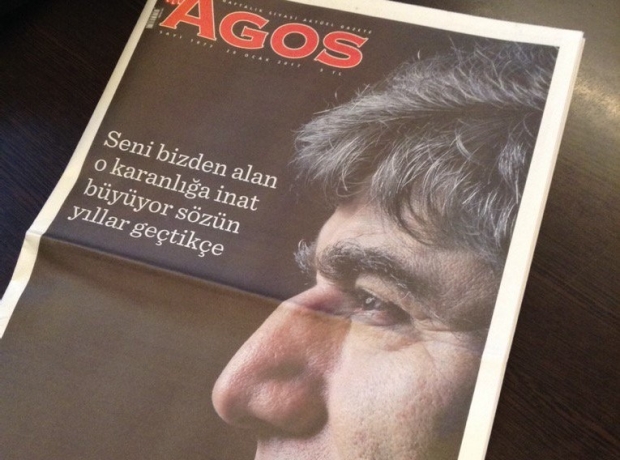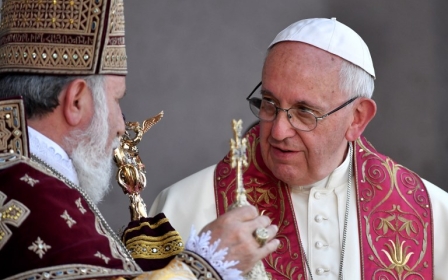10 years on, murder of Turkish-Armenian journalist remains unsolved
ISTANBUL, Turkey – Hundreds gathered in front of a newspaper office in Istanbul on Thursday to commemorate the brutal murder of a Turkish-Armenian journalist 10 years ago, and to ask why the case is still shrouded in mystery after a decade of court investigations.
On 19 January 2007, Hrant Dink was shot dead by an ultranationalist on a busy street in front of the offices of Agos, a left-leaning bilingual newspaper published in Armenian and Turkish and which belongs to the country’s tiny Armenian community.
Dink was editor-in-chief of the newspaper and wanted his work to heal wounds caused by the events of 1915, when hundreds of thousands of Turkey’s Armenians and other Christian minorities were exiled and endured untold hardships.
Dink and many others in the international community said the tragic events of 1915 amounted to genocide and that at least 1.5 million people were killed.
Turkey rejects the definition and says the deaths were part of the turmoil caused during the dying days of the Ottoman Empire. It also contests the number of deaths.
Turkey has repeatedly said it is willing to open its archives to international scholars to accurately determine the events of 1915.
Dink refused to engage in what he said was “genocide denial” even as he sought reconciliation and this is what enraged the ultranationalists.
The gunman Ogun Samast, from the Black Sea province of Trabzon, was arrested three days after the murder and tried but the case itself remains shrouded in mystery, which is yet to be resolved.
Former police and intelligence chiefs have been implicated in the murder. Some reports indicate they had prior knowledge of the planned assassination and did not act. Others state that they were involved in the assassination itself.
Ergenekon was allegedly seeking to topple Turkey’s government through a series of plots which would generate chaos.
Later in 2014 a top court dismissed the Ergenekon case, saying there was no proof to show the organisation even existed.
After Turkey’s ruling party openly fell out with the Fethullah Gulen movement toward the end of 2013, Dink’s murder was pinned on Gulenist forces who had infiltrated Turkey’s police, intelligence and judicial mechanisms.
Video footage even appeared allegedly showing Samast being feted by alleged Gulenist police officers while in custody.
Gulen is a US-based Turkish preacher who is also believed to be behind the failed coup attempt in July 2016.
Police were taking no chances Thursday for the planned private commemoration with increased security measures in place in the area of central Istanbul where the offices of Agos are located. Vehicular traffic on some streets was also prohibited as part of the security measures.
For the hundreds gathered to commemorate Dink with banners that read "We are all Hrant, we are all Armenian", the political mudslinging and the dragging on of the case through the courts neither provides closure nor does it help shed light on who was really behind the assassination.
Rakel Dink, his wife, in an emotional speech during the commemoration, called for an end to the fear of "peace" doves in this country.
“10 years is easy on the tongue. But an entire 10 years without you is not easy at all. Being unable to be alongside you, alongside the one you love is painful and even more painful and full of sorrow when you were taken from me through a devious plan,” she said.
“But what can I say to those who have shared a similar grief for 20, 30, 40 years? What can I say to those who had their children killed?”
She went on to recount the painful moments the country has been through in the 10 years since Dink’s murder and called on everyone to learn the meaning of coexistence and understanding one another.
Defining the mass deaths of Armenians and other Christians in 1915 as genocide is one of Turkey's biggest foreign-policy headaches. Ankara has attempted to use its clout to prevent legislatures of various countries from passing bills that would define it as such.
The two countries that matter most for Ankara in this context are the US and Germany. The US has never gone further than calling it “Meds Yeghern”, or Great Tragedy, a decision believed to be in large part because of the strategic importance of ties with Turkey.
Ties with Germany were strained in June last year when the German Bundestag voted to recognise the events of 1915 as “genocide”. Relations improved only after the German government assured the Turkish government that it would not endorse the Bundestag’s ruling.
Last week Garo Paylan, an Armenian MP from the ranks of the pro-Kurdish Peoples’ Democratic Party (HDP), was banned from three parliament sessions for calling the 1915 events genocide.
His remarks, which came during debates on the controversial constitutional amendments bill, caused outrage among MPs from other parties.
Turkey’s ruling Justice and Development Party (AKP) and the opposition Republican People’s Party (CHP) each have an Armenian-origin MP in their ranks as well.
New MEE newsletter: Jerusalem Dispatch
Sign up to get the latest insights and analysis on Israel-Palestine, alongside Turkey Unpacked and other MEE newsletters
Middle East Eye delivers independent and unrivalled coverage and analysis of the Middle East, North Africa and beyond. To learn more about republishing this content and the associated fees, please fill out this form. More about MEE can be found here.






